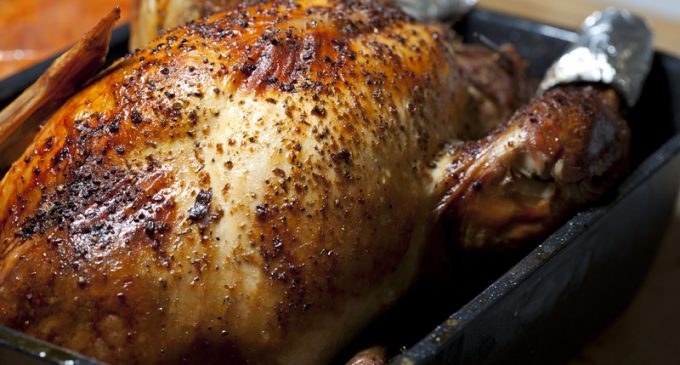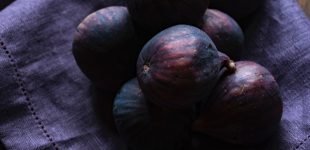
Here's everything every cook needs to know about making the perfect turkey. This is certainly a comprehensive list!
Check This Out…
Getting Started
While we all know the tryptophan in turkey can make us doze off on the couch after our Thanksgiving feast, something that surprised us about the tasty bird is that it’s actually packed with a lot of essential nutrients. Aside from being low in fat and high in protein, turkey is also a great source of riboflavin and phosphorous.
Many of us are familiar with how to roast turkey, but did you know you can also slow-cook, grill, or deep-fry your bird? We’ll walk you through each method and offer up helpful hints on how to make the most out of your bird.
What you’ll need:
While nice-to-have cooking tools may vary by preparation, here are some of the essentials you’ll need for any method:
Meat thermometer
Aluminum foil
Sharpened carving knife/fork
Cutting board
Other tools that vary by method:
Depending on whether you’re roasting, grilling, slow cooking or deep-frying, you may need a few other tools.
For Roasting:
Oven-proof meat thermometer
Roasting pan with handles
Butcher’s string
BasterFor Deep-Frying:
Large, 28-30 quart stockpot or turkey fryer
An oven-proof meat thermometer is nice for any method because you can leave it in the turkey while it’s cooking, as opposed to a regular meat thermometer which you’ll have to stick in the bird at intervals in order to determine whether or not it’s done. This especially comes in handy if you’re roasting your bird in the oven, as opening and closing the oven door repeatedly lets out heat and interrupts your turkey-cooking time. Because cooking times vary, also be sure you’re meat always reaches 165ºF before serving.
If you’ll be roasting your bird, a roasting pan with handles is also a smart idea because of the turkey’s weight. The size of pan you should use depends on the size of your bird, but in general, anything up to a 12 lb turkey can be roasted in a 14 x 10 pan. Larger birds should be roasted in a 16 x 13.
Other nice-to-have tools for roasting include butcher’s string and a baster. We use butcher’s string to tie the legs of the turkey together—it’s inexpensive and available at most cookware stores. Also, if you’re going to baste your turkey, which helps give the turkey plenty of flavor, you’ll need a baster.
Buying a Turkey
Before you can get to work cooking your turkey, you’ll need to choose from one of the handful of varieties sold in stores. You can purchase fresh or frozen, depending on when you’ll be serving the turkey. A fresh turkey can be kept in the refrigerator for one to two days before serving, so it’s your best bet if you’re planning on preparing it soon. Turkeys can be frozen in the freezer for up to 12 months.
Wondering how much turkey to buy for your guests? You can figure this out by multiplying the number of guests by one pound of uncooked, whole turkey per person. This equation gives you enough for the table as well as a few leftovers, which are especially nice on Thanksgiving. Turkeys can range in size anywhere from eight to 24 pounds.
Which Type of Turkey is Right for You?
There are many types of turkeys to choose from, and the kind you should select depends on the occasion and your personal preferences.
Free-range
If a turkey is free-range, it means the bird has been given access to the outdoors. Free-range turkeys are generally moist and have a robust turkey flavor, but can be a bit more expensive than other options.
Organic and Natural
When a turkey is labeled as organic, it means it’s free of hormones and antibiotics. Organic turkeys may be slightly more expensive, but they often have a delicious, substantial flavor. If a turkey is labeled as natural, it means it is free from preservatives and artificial ingredients, and can only be “minimally processed.” Again, these turkeys might be slightly more expensive, but are, in general, more flavorful.
Kosher
For a turkey to be labeled as kosher, it needs to be processed in accordance with Jewish dietary law under rabbinical supervision. Kosher turkeys are soaked and salted, then triple rinsed. For this reason, they typically don’t require additional brining.
Heritage
Wondering what a heritage turkey is? If a turkey is labeled as heritage, it means it comes from some of the first domesticated turkeys farmed by the English settlers. There are two main heritage breeds: American Bronze and Bourbon Red, which both have a bit more dark meat than other types of turkeys. Heritage turkeys are some of the best birds to slow-cook because of their moist, slightly chewy texture. They are substantially more expensive than other turkeys.
Self-Basting
A self-basting turkey is generally less expensive than organic or natural turkeys. It has been filled with ingredients like salt, butter, or chicken fat to make it more flavorful and moist—hence, there’s no need to baste it. In general, these turkeys produce juicier meat than other varieties.
Conventional
Conventional turkeys will be less expensive than organic turkeys, but may have added hormones or antibiotics, depending on where they come from. If you like, talk to your butcher about what types of turkey he recommends for the cooking method and meal you’re planning.
How to Store Your Uncooked Turkey
So you’ve purchased the turkey, you’ve selected your cooking method and have a killer recipe to boot…now what? If you want to keep your turkey frozen, remember that it can be stored in the freezer for up to 12 months.
But if you’re making it soon, a fresh, whole turkey should only be refrigerated for up to 1 to 2 days of purchase. Always keep the turkey in its packaging from the store; the wrapping it comes in is designed to keep bacteria out and freshness in. Taking off the packaging may expose your bird to bacteria.
How to Prepare your Turkey Before Cooking
If your turkey has been in the freezer, you’ll need to thaw it. Thawing a turkey is easy, and can be done in three different ways:
In the refrigerator, using our thawing chart for guidelines on how long it will take based on size.
In the microwave—if your turkey is tiny enough! Just check your owner’s manual for instructions on minutes per pound and be sure to unwrap turkey before doing so.
With cold water that completely covers the bird. To do this, place turkey in plastic bag in cold water, submerging completely. Change water every 30 minutes to ensure water is cold. You can plan for 30 minutes of defrosting per pound of bird.
Once thawed, do the following:
Remove the wrapper and paper giblet packets containing the gizzard, heart, and neck. These are tucked inside the neck and end cavities—be sure to check both.Rinse the turkey well after removing the giblets and pat dry. Giblets can be rinsed and cooked in a saucepan of boiling water and simmered during turkey roasting time.
How to Stuff and Truss a Turkey
If you’re making a Thanksgiving turkey, you may want to stuff your bird before cooking it. Stuffing that’s prepared inside the turkey becomes extra moist and flavorful, although it does mean additional cooking time. If you need to save time to prepare your feast, make stuffing outside of the bird instead.
If you’re committed to stuffing your turkey, however, here are a few things to consider:
All stuffing ingredients should be cooked before they are placed inside the turkey, including the meat and vegetables.
In general, you’ll use about ½ to ¾ cups of stuffing per pound of turkey to stuff both the neck and body.
Do not stuff your bird the night before; letting stuffing sit inside it that long can let bacteria grow: it’s best to stuff the bird right before roasting.
Just like the turkey, the stuffing needs to reach a safe temperature of 165ºF before serving. If the turkey is done before the stuffing, remove the stuffing and continue to cook in a baking dish.
Trussing your turkey simply means tying it into a compact shape. Some people believe this helps the turkey cook more evenly. We like to use twine or butcher’s string to do this, especially when roasting, but trussing is not a necessary step if you don’t have time.
How to Brine a Turkey
Brining a turkey before cooking it adds plenty of flavor and makes for extra-tender meat. There are two ways to brine a turkey: using a wet brine or with a dry brine.
While it does require additional prep time—up to 24 hours for the brine to soak in—we suggest giving a brine a try if you have the time and want more flavorful, tender meat.
Wow!
This certainly is a comprehensive list, and we're not nearly so intimated by the prospect of cooking a whole turkey now that we have these tips and tricks.
Let's Get Started!
Article Source: Betty Crocker


Sharing this recipe at https://www.facebook.com/downhomecomfortfoodrecipes
The last two years I have wrapped my turkey in bacon. It has been the best turkey ever two years in a row!